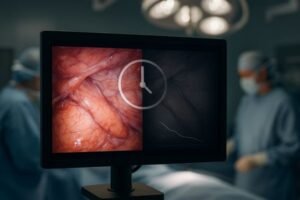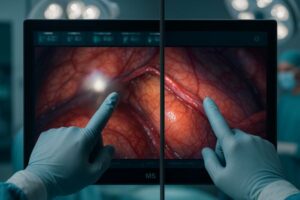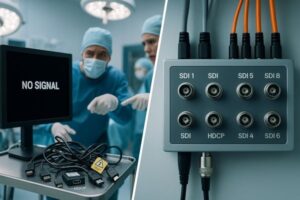In a busy operating room, a surgeon views a screen from a side angle. The image appears dim and colors are distorted, hiding a subtle bleed and compromising patient safety.
In endoscopic surgery, viewing angle is critical to ensure that every member of the operating team sees the same accurate image. Ultra-wide viewing angle displays deliver consistent brightness, contrast, and color fidelity across 178°, improving safety, communication, and efficiency in the operating room.
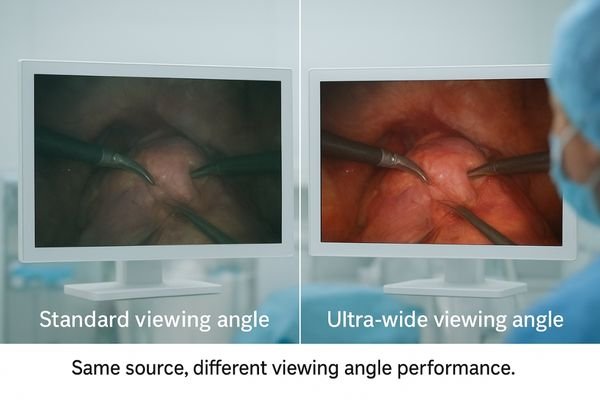
The modern operating room (OR) is a collaborative, high-stakes environment where precise visual information is paramount. During minimally invasive procedures, the entire surgical team relies on a monitor to see inside the patient’s body. The quality of that image, and how consistently it is displayed, can directly impact procedural outcomes. A key, but often overlooked, specification is the display’s viewing angle. A slight shift in a surgeon’s position or a nurse’s viewpoint can dramatically alter the perceived image on a standard monitor. This article will explore the critical differences between standard and ultra-wide viewing angle displays1, detailing their impact on image fidelity2, team collaboration, and ultimately, patient safety in the surgical setting.
Standard Viewing Angle vs Ultra-Wide Viewing Angle
A surgeon leans to the side for a better look. On a standard monitor, the image darkens and colors change, creating dangerous uncertainty at a critical moment.
Standard viewing angles limit optimal image quality to a narrow cone, while ultra-wide angles offer a consistent image across nearly 180°, ensuring accurate color and contrast from any position.
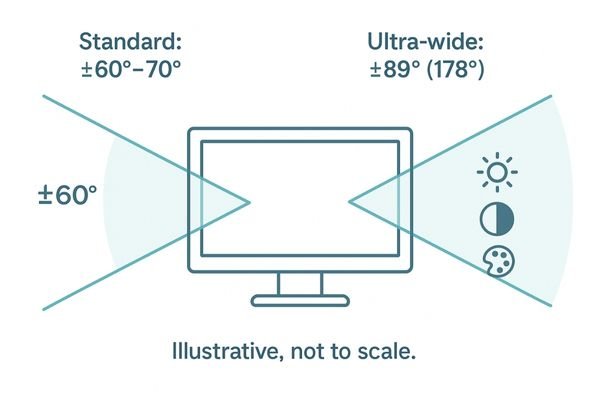
In the context of medical displays, the term "viewing angle3" defines the range from which a screen can be viewed without significant degradation in image quality. A "standard" viewing angle, often found on displays using older panel technologies, typically maintains optimal brightness, contrast, and color within a limited cone, for example, ±60° to ±70° from the center. Beyond this range, performance drops off noticeably. In contrast, ultra-wide viewing angle displays4 are engineered to provide a consistent image across a much larger cone, often up to ±89° both horizontally and vertically. This means that critical visual information—such as the exact shade of tissue color or subtle variations in contrast—remains accurate and reliable, even when a surgeon or other team member views the monitor from an extreme side angle. A display like the MS270P with its wide viewing capabilities ensures that this consistency is maintained, which is fundamental for collaborative medical environments where team members are positioned all around the display.
Image Fidelity at Off-Axis Viewing Angles
Viewed off-center, a standard monitor can make red blood appear brownish or dull. This color shift can cause a surgeon to misjudge the severity of bleeding.
At steep angles, standard panels suffer significant drops in contrast and major color shifts. Ultra-wide angle displays maintain grayscale and color accuracy, preserving critical details like tissue shading and vessel structure from any viewpoint.

A medical display must preserve every critical image detail, regardless of the viewing position. On a standard monitor with a limited viewing angle, even a moderate shift off-center can have a dramatic impact. The contrast ratio can drop by over 50%, and colors can shift significantly, often introducing a visible bluish or yellowish tint. This degradation can easily obscure subtle but vital information. In contrast, high-end ultra-wide angle displays5 are designed to maintain tight grayscale gamma and color accuracy, often to within a few Delta E units, across the full 178° viewing cone. This ensures that the subtle shading of tissue planes and the rich tones of blood vessels remain clearly distinguishable across the entire viewing plane. An advanced 4K surgical monitor6 like the MS275PA will present a virtually identical image whether viewed head-on or from the side. This consistency is not a luxury; it is a necessity for endoscopic and laparoscopic surgery, where the accurate visualization of fine structures can directly influence critical surgical decisions.
Operating Room Viewing Environment
In a brightly lit OR, reflections on a screen can hide details. A monitor with a narrow viewing angle becomes almost unreadable to staff not standing directly in front.
Operating rooms have dynamic and bright viewing conditions. Ultra-wide viewing angles ensure the image remains clear for all team members, regardless of their position or the ambient lighting.

The operating room is a uniquely challenging environment for visual displays. Bright, focused overhead lights, team members moving around the table, and equipment mounted on articulating arms create a dynamic where viewing angles are constantly changing. An ultra-wide viewing angle is essential to accommodate these conditions. It ensures that nurses, anesthesiologists, and assistants can see a clear, accurate image even when viewing the monitor from the side, at a downward tilt, or from across the room. A standard-angle display, by contrast, could appear washed out or dim from these positions, forcing staff to move or reposition themselves, potentially disrupting the workflow. Surgeons themselves often need to tilt or turn their heads during complex maneuvers, and a loss of image quality during these moments is unacceptable. An ultra-wide viewing angle display like the MS321PB is specifically designed to handle this reality, accommodating the full range of head movements and team positions to minimize blind spots where critical information could be missed.
Multi-Viewer Situations and Team Collaboration
An assistant surgeon points to a structure on screen. With a narrow-angle display, the lead surgeon sees a different color, leading to a confusing and potentially dangerous miscommunication.
Ultra-wide viewing angle displays provide a shared, high-fidelity view for the entire surgical team. This ensures precise communication and enhanced coordination, as every member sees the exact same visual information.
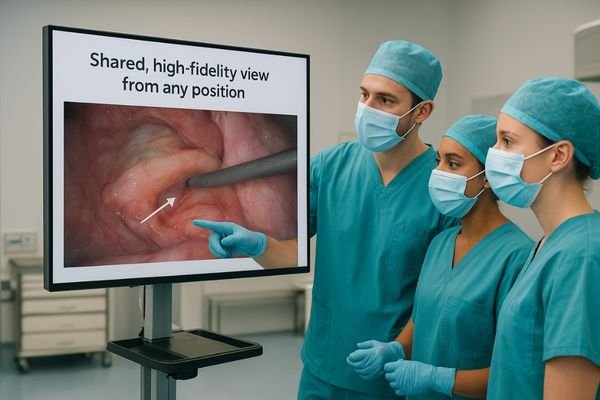
Modern surgery is a team sport. Endoscopic and robotic procedures routinely involve a lead surgeon, one or more assistants, nurses, and often trainees, all relying on the same monitor for situational awareness. Ultra-wide viewing angle displays7 are critical for effective teamwork because they guarantee that every viewer sees the same high-fidelity image. This shared visual truth enables precise, unambiguous verbal communication. When the lead surgeon references a feature on the screen, there is no risk of misinterpretation caused by brightness or color discrepancies between different viewing positions. In contrast, with a narrow-angle monitor, a side observer might see a darker or differently tinted image, leading to confusion and potentially delaying action. By ensuring a consistent view, an ultra-wide angle monitor like the MS322PB helps all team members anticipate the lead surgeon’s actions, enhancing coordination and efficiency. In teaching and tele-mentoring scenarios, this allows observers to lean in from any angle without image degradation, fostering a better learning environment.
Impact on Surgical Accuracy and Safety
Viewed from the side, a standard monitor fails to show a small bleed. The delay in response could lead to serious complications for the patient.
Ultra-wide viewing angles are directly linked to surgical accuracy and safety. By maintaining contrast and color uniformity, they minimize the risk of missing subtle cues, ensuring the entire team can act on critical information immediately.
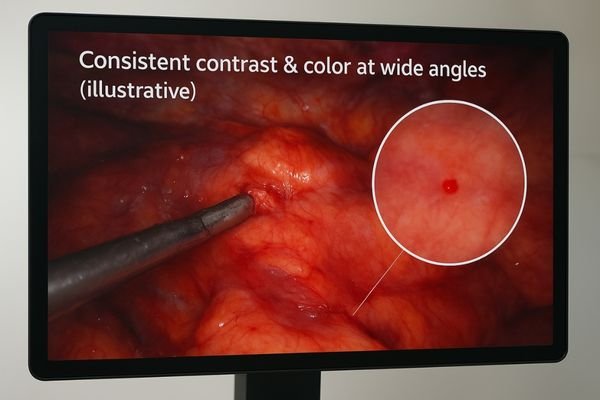
The link between display quality and surgical outcome is direct and undeniable. A monitor with a limited viewing angle poses a significant risk because it can hide subtle but critical visual cues when viewed off-axis. For example, a drop in perceived brightness could mask a small bleed, or a shift in color could obscure an anomalous tissue texture. Ultra-wide viewing angles mitigate this risk by ensuring contrast and color appear as intended, regardless of the viewing position. This directly translates to higher surgical accuracy8 and improved patient safety. Every member of the team can trust what they see, allowing them to spot and react to critical events—such as bleeding or misidentified anatomy—immediately. Medical standards emphasize the need for displays that support multi-angle viewing without degradation precisely because any discrepancy can compromise life-or-death decisions. With ultra-wide angle displays like the MS430PC, surgical teams can maintain their optimal ergonomic positions, reducing fatigue and procedural disruption while ensuring no critical visual information is ever lost due to a poor viewing angle.
Panel Technologies: IPS vs TN vs VA
Choosing a monitor with the wrong panel technology is a critical error. A TN or VA panel may save costs but will fail to deliver the consistent view required in surgery.
IPS panel technology is the standard for surgical displays due to its superior color consistency and symmetric 178° viewing angles, far outperforming the limited angles of TN and VA panels.
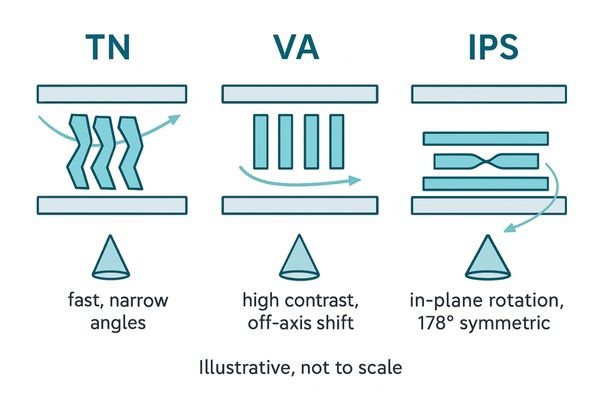
The viewing angle performance of a display is fundamentally determined by its underlying LCD panel technology. There are three main types, each with distinct characteristics.
- TN (Twisted Nematic)9 panels are common in low-cost consumer monitors. They offer fast response times but have the narrowest viewing angles, with significant color distortion occurring beyond 30°-60°.
- VA (Vertical Alignment) panels provide excellent contrast ratios when viewed head-on, but they still exhibit noticeable color and gamma shifts at off-axis angles.
- IPS (In-Plane Switching)10 panels are the preferred technology for surgical and other medical-grade displays. In an IPS panel, the liquid crystals rotate parallel to the screen, allowing light to pass through more consistently from all directions. This results in superior color accuracy and wide, symmetric viewing angles of up to 178°. A modern IPS-based surgical monitor like the MS550P will show minimal color shift even at extreme tilt angles, making it the industry standard for collaborative environments like the operating room.
| Panel Type | Viewing Angle Performance | Primary Advantage | Primary Disadvantage |
|---|---|---|---|
| TN | Narrow (±60°) | Fast Response Time | Poor color at off-angles |
| VA | Moderate | High Contrast Ratio | Off-axis color/gamma shift |
| IPS | Ultra-Wide (±89°) | Excellent Color Consistency | Higher cost |
Optical Bonding and Anti-Glare Design
Internal reflections in a standard display create a "ghost" image. In a critical surgical moment, this distraction can lead to confusion and incorrect instrument placement.
Optical bonding and anti-glare coatings are crucial technologies that complement wide-angle panels. They eliminate internal reflections and diffuse external glare, maximizing contrast and readability from every angle, especially in a bright OR.
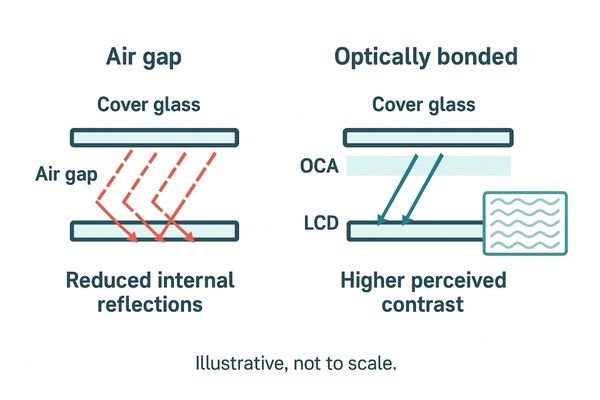
To maximize visibility at extreme angles, especially in the bright ambient light of an OR, advanced surgical displays use technologies that go beyond the panel itself. One of the most important is optical bonding11. This process involves applying a layer of optical-grade adhesive to eliminate the air gap between the LCD panel and the protective front glass. This single step provides two key benefits: it significantly reduces internal reflections that can cause a "ghosting" effect, and it increases the perceived contrast ratio. The result is a sharper, clearer image that is much more readable when viewed off-axis. This is complemented by a high-quality anti-glare (AG) coating12 on the front surface. The AG coating uses a micro-textured finish to diffuse reflections from strong overhead surgical lights. Together, optical bonding and anti-glare coatings work in concert with an ultra-wide viewing angle panel to ensure that the image remains crisp, clear, and diagnostically accurate under all viewing conditions.
Color Consistency and Calibration
Even with a wide viewing angle, uncalibrated colors are a liability. If the monitor doesn’t accurately represent red, a surgeon cannot properly assess blood flow or tissue perfusion.
Wide viewing angles must be paired with precise color calibration. Medical displays use advanced LUTs and color management to ensure that critical hues like red are rendered faithfully and consistently across the entire screen, from every angle.
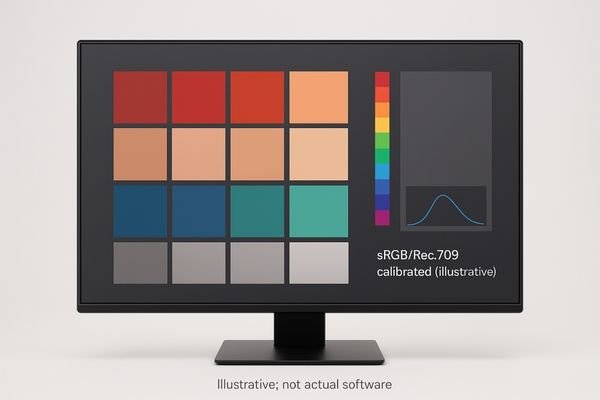
While an ultra-wide viewing angle is essential for preventing brightness and contrast shifts, it must be paired with rigorous color management13 to be clinically effective. The display must be able to reproduce colors with a high degree of accuracy and consistency, not just at the center of the screen, but across the entire panel and from every viewing position. Medical-grade surgical displays achieve this through factory calibration using high-bit-depth Look-Up Tables (LUTs)14. This process maps the display’s native color capabilities to standardized color spaces, such as sRGB or Rec. 709, ensuring that the image from the endoscopic camera is rendered with complete fidelity. This is particularly critical for the accurate representation of reds and tissue tones, which provide vital information about perfusion, bleeding, and tissue health. Maintaining this color consistency across the entire 178° viewing cone ensures that all members of the surgical team are making decisions based on the same, accurate visual data, eliminating a dangerous variable from the procedure.
Considerations for Medical-Grade Monitors
A monitor may have a wide viewing angle, but if it cannot be easily cleaned or withstand the rigors of the OR, it is not a viable solution.
Choosing a surgical display requires balancing ultra-wide viewing angle with other critical features: high brightness, sealed and easily cleanable housings, certified power supplies, ergonomic adjustability, and low-latency connectivity.
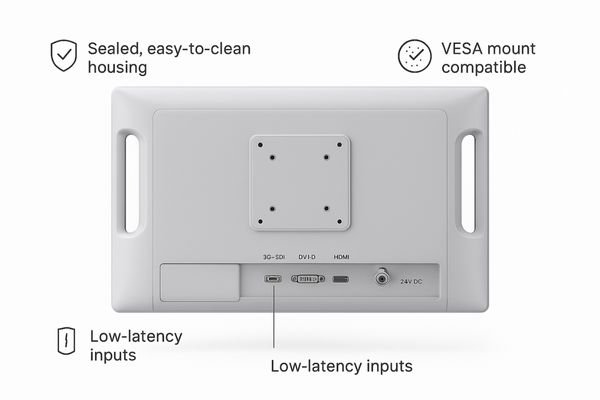
While an ultra-wide viewing angle is a cornerstone feature, it is just one piece of the puzzle when selecting a surgical display. A true medical-grade monitor15 must meet a host of other stringent requirements to be safe and effective in the operating room. Brightness is critical, with displays needing to output 500 cd/m² or more to overcome bright ambient surgical lighting. The physical design must be robust, with sealed, fanless housings that are easy to clean and disinfect to maintain a sterile field. Power supplies must be medically certified (e.g., 24V DC input) to prevent electrical interference with other OR equipment. Ergonomics are also key; the monitor must support quick and easy tilt, swivel, and height adjustments to accommodate surgeons who may switch between standing and seated positions. Finally, it must offer a range of low-latency video inputs16 (like 3G-SDI, DVI, and HDMI) to connect seamlessly with various endoscopic camera systems. A truly effective surgical display successfully integrates all of these features to provide a reliable, safe, and high-performance visualization tool.
Conclusion
Ultra-wide viewing angle medical-grade displays are not a luxury but a necessity in the modern OR, ensuring the entire surgical team sees a consistent, accurate image for enhanced safety and collaboration.
👉 For expert recommendations on surgical displays with ultra-wide viewing angles, reach out to Martin at martin@reshinmonitors.com — we’ll help you choose the right solution for your OR.
-
Explore how ultra-wide viewing angle displays enhance image fidelity and team collaboration in surgical settings. ↩
-
Learn about the crucial role of image fidelity in ensuring successful surgical outcomes and patient safety. ↩
-
Understanding the significance of viewing angle can enhance your knowledge of display technologies crucial for medical environments. ↩
-
Exploring this topic reveals how advanced display technologies can enhance surgical precision and team collaboration. ↩
-
Explore how high-end ultra-wide angle displays enhance medical imaging by maintaining color accuracy and detail, crucial for surgical precision. ↩
-
Learn about the essential features of advanced 4K surgical monitors that ensure optimal image quality for critical surgical procedures. ↩
-
Explore how ultra-wide displays enhance surgical teamwork and communication, ensuring everyone sees the same high-quality image. ↩
-
Learn about the crucial link between display quality and surgical outcomes, emphasizing the importance of visual clarity in medical procedures. ↩
-
Learn about the drawbacks of TN panels, including their narrow viewing angles and color distortion, to make informed display choices. ↩
-
Explore the benefits of IPS technology, known for its superior color accuracy and wide viewing angles, essential for high-quality displays. ↩
-
Understanding optical bonding can enhance your knowledge of how surgical displays improve image clarity and reduce reflections. ↩
-
Exploring AG coating will reveal its role in enhancing visibility and reducing glare in bright surgical environments. ↩
-
Understanding color management is crucial for ensuring accurate and consistent color reproduction in medical displays, which is vital for patient safety. ↩
-
Exploring LUTs will reveal how they enhance color accuracy in displays, essential for critical medical applications. ↩
-
Explore this link to understand the essential features and standards that define a medical-grade monitor, ensuring safety and effectiveness in surgeries. ↩
-
Discover why low-latency video inputs are crucial for seamless integration with endoscopic systems, enhancing surgical precision and efficiency. ↩

